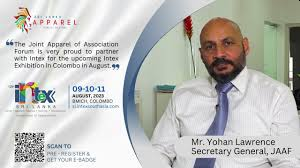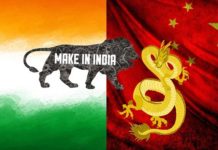Yohan Lawrence wants to make Sri Lanka the world’s key apparel exporter
In conversation with FPJ, Lawrence reveals Sri Lanka’s remarkable progress in the apparel industry, its shortcomings and how he aims to set Sri Lanka apart as a sourcing destination for the global apparel manufacturers.

In conversations with Dominic Rebello and RN Bhaskar, (both from the Free Press Journal) Lawrence reveals Sri Lanka’s remarkable progress in the apparel industry, its shortcomings and how he aims to set Sri Lanka apart as a sourcing destination for the global apparel manufacturers.
I believe there were a few key factors contributing to our initial success. One of the main elements was the confidence of our customers. When someone placed an order with Sri Lanka, they had complete knowledge about the factory conditions where the product was being made. They enjoyed full visibility, transparency, and the assurance that their order was in good hands. Additionally, we had established a reputation for product quality, reliable service delivery, excellent value for money, and meeting customer expectations.
From a customer’s perspective, when placing an order, they seek assurance that the product will arrive on time, at the right price, and exactly as ordered. Sri Lanka, despite being a relatively small player on the global stage, provided this level of assurance, combining product quality with other important factors to ensure that the product was in safe hands.
China Is a big daddy in garments globally, But its labor costs are increasing and that is why some of the business that China does is being farmed out to various other countries. Has Sri Lanka benefitted from that or does have its own strategy?
We haven’t benefited as much as we would have liked, and there are several reasons for this. One significant factor is that Chinese factories operate on a much larger scale than Sri Lanka, making it impossible for Sri Lanka to fill that gap. Sri Lanka’s apparel exports are, at best, around 5 to 6 billion dollars, while China’s exports exceed 40 billion dollars. The difference is massive, and it’s challenging to replicate China’s scale.
However, where we have made progress is by working more closely with our existing customers who are already embedded in their own supply chains. This has led to some movement of products, perhaps with a slightly different value proposition compared to what you might find when sourcing from China. Each country brings unique strengths to the table, and the transition from one to the other isn’t automatic.
So, regarding whether we have successfully attracted this business, perhaps not to the extent we hoped for, but there has been some progress. We are now engaged in more conversations with both existing and new customers who express interest in exploring what Sri Lanka has to offer.
I was recently speaking to Chinese electronics company TP Link and they said that the the labor costs in India are 1/3 when compared to China. So they have shifted 50% of their productions to India. How do Indian labor costs compare with Sri Lanka labour costs?
I don’t actually have a definitive answer to that question. To be completely honest, I’m not certain about how Sri Lanka compares to India in terms of labor costs. It’s a complex issue, and there are many variables to consider. When you look at places like Bangladesh and others in the region, there isn’t always a clear distinction.
The challenge here is that people often focus on a few specific metrics, such as a country’s minimum wage, average industry wages, or median wages. However, the reality is more intricate. In addition to the basic wage, there are various incentives, allowances, and overtime payments. Moreover, there are non-cash benefits like transportation, meals, medical coverage, and uniforms provided by employers. This makes it challenging to arrive at a precise comparison.
In Sri Lanka, for instance, most companies pay well above the legal minimum wage because offering only that wage would not attract the necessary workforce. So, it’s difficult to pinpoint a straightforward answer. The most commonly cited metric is the legal minimum wage, but it doesn’t necessarily reflect the full picture.
I have watched with admiration how MAS and Brandix (the two Sri Lankan companies) offer extended facilities to its workers. At the same time I have seen Brandix, opening a large center in India to source fabrics. Could also be because it may be cheaper to make it in India and the company is also looking at the Indian domestic market now?
I agree with your assessment. To my understanding, part of the motivation for moving into the Indian market was indeed to tap into the Indian domestic market and promote the concept of “Made in India for India.” There has been a significant shift in that direction, and there was a belief that this presented an opportunity for establishing operations in India to cater specifically to the Indian market.
Indian garments manufactures are relatively small. The scale at which Brandix is setting up a unit in India is large. So they have the experiences of setting up large units and they replicating that in India and I hope they win because if they win it then maybe you can get some of the Chinese businesses into India?
I believe that makes perfect sense. Having a wider range of manufacturing options indeed keeps the possibilities open. For brands, the decision on where to place their manufacturing is influenced by several factors, including duty structures in their target markets, operating costs, and other considerations. So, there are multiple factors at play in determining why a particular country is chosen. Naturally, the more options we can offer to our customers, the better positioned we are to meet their needs effectively.
Bangladesh has also been quite successful and garments but that is also because they have favorable import export options with Europe and America. And I believe that they are concessional export the facilities have been extended by the EU till 2026. How much of Bangladeshi successes in this sector can be attributed to these special export-import facilities? And how much of it benefits Sri Lanka?
I agree with your assessment. When we consider the European Union (EU), the United Kingdom (UK), and their Least Developed Country (LDC) status, Bangladesh enjoys virtually unrestricted market access to these countries, as well as India. This is a significant advantage because it allows them to manufacture garments using fabric purchased from various locations, as long as they meet the requirements specified under the LDC schemes.
However, when we look at the same situation from Sri Lanka’s perspective, there are differences in the schemes. Sri Lanka has to use fabric that originates from the EU or the UK or Sri Lankan-made or from a South Asian Association for Regional Cooperation (SAARC) country to qualify. Accumulation is only allowed within SAARC countries, limiting the fabric sources to Sri Lanka, India, and Pakistan. Fabrics from Bangladesh, for example, are generally not used in Sri Lanka. In contrast, Dhaka’s fabric industry relies heavily on imports from China.
As a result, only around 50% of what Sri Lanka exports to the EU and the UK qualifies for LDC facilities due to the restrictions on fabric origin.
So that is a restrictive factor which prevents you’re growing as big as Bangladesh?
Certainly, Sri Lanka will never reach the same scale as Bangladesh due to differences in landmass and population. We don’t have the same resources in terms of sheer size and workforce. However, there is potential for Sri Lanka to grow into a larger and more significant business than it is today if we seize the right opportunities. So, I believe that’s one of the key factors to consider.
MAS employs over 90,000 people, while Brandix employs over 60,00 people. These are very large numbers compared to many of the units in India. Now, what would be the entire number that the entire garment industry in Sri Lanka employs?
The total number of employees in the industry is approximately 3,50,000 people who work within the plants. However, it is important to understand that the economic footprint extends beyond this number. In Sri Lanka, these plants are not exclusively located within industrial zones. While some are situated near cities, others are in more remote areas. When considering the broader impact on people, it’s likely that the industry affects closer to a million individuals indirectly.
But in terms of direct employment within the sector, the figure stands at around 350,000 people. It’s worth noting that these numbers you mentioned may encompass the total group numbers for companies like Brandix and MS.
Yes, they are group numbers. But even then, as a group, it is a very large number…
Certainly, I believe they are likely among the largest private sector employers in Sri Lanka. While I am not certain about the specific numbers for other companies, it’s doubtful that many of them employ anywhere close to 90,000 or even 60,000 people. As employers, they are likely among the top three in terms of workforce size.
Nearly 3,50,000 people employed by the garment industry. How many units do you think are there are in Sri Lanka?
By our estimation, there are approximately 350 individual manufacturing units. It is worth noting that many of these units may operate under a single brand or company, but when counted individually, there are around 350 such units.
Given the times that we are in, where more and more countries are restricting imports of other countries and globalization as a concept is under threat, what are Sri Lanka’s long term strategy is to remain a vibrant player in this industry?
This issue stems from the question of fabrics and their connection to the EU and the UK. Sri Lanka, being a small country, faces some unique challenges. Unlike several competitors, we lack the vast landmass, abundant water resources, and a large population needed to establish ourselves as a global raw material hub. The scale of those industries is such that we couldn’t solely serve Sri Lanka; we’d have to be export-oriented.
The Sri Lankan market’s limitations present a challenge. Brands are increasingly expressing interest in sourcing materials as close to Sri Lanka as possible. They are contemplating reducing the distance they import from, shifting from sources thousands of miles away to ones closer, possibly within 2,000 miles. These discussions arise from practical constraints. While we would ideally want our entire raw material base in Sri Lanka, this isn’t economically feasible.
Moreover, the conversation is shifting more toward sustainability. People are inquiring about the carbon footprint associated with making fabric in one location and then moving it to another. For us, sustainability is becoming a primary driver in raw material discussions. In an ideal world, everything would be made in Sri Lanka, but practicality dictates otherwise.
Another challenge is the diversity of fabric types. There’s a vast array of HS code numbers associated with fabrics, making it difficult for a small country like Sri Lanka to compete effectively. This poses a significant challenge when our overall business volume is relatively low.
The garments industry is supposed to be a shifting industry. I can’t see garments shifting away from Bangladesh or Sri Lanka, what’s your views?
I completely agree. Especially when it comes to Sri Lanka, what we have been doing over the past few years is making it more appealing for brands to consider Sri Lanka as a valuable partner. We have accomplished this by expanding the range of services we offer. This includes collaborating with our design and product development teams, working closely with their warehousing teams, and extending our involvement throughout the supply chain. We have evolved from being just a garment manufacturer in the middle of the process.
By taking these steps, we have encouraged brands to engage more deeply with us. Some brands have even set up dedicated product development and design centers with our assistance. This approach allows us to add value to their operations. We understand that Sri Lanka isn’t the cheapest option available, so our goal is to provide customers with a wider range of services.
For instance, if a product is going to the UK and relies on locally-made fabric or any suitable fabric, we can manufacture it cost-effectively in Sri Lanka. For very high-volume products that require factories with over 5,000 employees, we recognize that Sri Lanka may not be the right location. In such cases, we can help our customers find the most suitable manufacturing location while maintaining a single point of contact through Sri Lanka.
The key is to offer our customers the flexibility to manufacture in different locations under the same brand. This adds value by simplifying the process. Instead of having separate conversations with different suppliers in various countries like Vietnam or Bangladesh, customers can have one comprehensive conversation with Sri Lanka. We work together to determine the best location for each specific product. This flexibility is crucial because it allows us to adapt to changing circumstances, such as shifts in politics or other factors that affect production.
Ultimately, our ability to provide customers with a complete solution, tailored to their needs, is what keeps Sri Lanka relevant in this conversation. Whether they want design and development in Sri Lanka and production elsewhere, or specialized products crafted in Sri Lanka, we have the breadth of services to accommodate their requirements.
How many countries has Sri Lanka gone to manufacture, like Brandix has done in India?
We have manufacturing operations in Vietnam, Indonesia, Cambodia, Bangladesh, India, Egypt, and various locations in Africa. Essentially, we have a presence wherever there is a compelling case for manufacturing.
So wherever there’s an advantage from markets in the proximity..
Indeed, many of these decisions revolve around the specific product and the market it’s intended for. If it makes sense to produce a garment closer to a particular market, then that’s the direction we go. So, the network is well-established to support these considerations.
Is the garments industry in Sri Lanka subsidized by the government in any way or is it independent?
The government has never provided any subsidies. Instead, it supports the industry through strategic policies and by creating an enabling environment that allows companies to operate effectively.







































COMMENTS